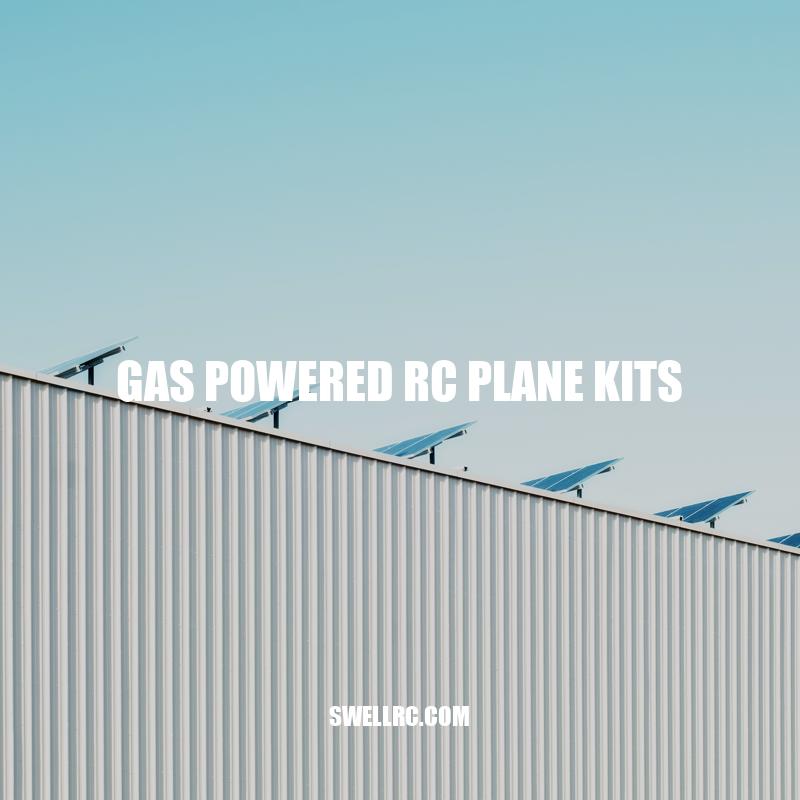Building and Flying Gas Powered RC Plane Kits: A Comprehensive Guide
Building and flying remote control planes is a fascinating hobby that is enjoyed by enthusiasts of all ages. While there are different types of remote control planes, such as electric and glider planes, gas-powered remote control planes offer a unique and thrilling experience for model aircraft enthusiasts. Gas-powered remote control planes rely on a small internal combustion engine to power the plane, which offers several benefits over electric and glider planes. These planes have a greater range, can fly for longer durations, and can reach higher speeds. Due to the power offered by the internal combustion engine, gas-powered RC planes can also perform more complex tricks and stunts in the air. However, building a gas-powered remote control plane requires a solid understanding of the model and various important components. The process involves selecting the right gas engine, assembling the different parts, configuring the electronic systems, and conducting several tests before the plane can take to the skies. This article will provide an in-depth guide on building gas-powered remote control planes, including the necessary equipment, building tips, and troubleshooting techniques to help readers build their own plane and explore the skies with confidence.
Gas-powered remote control planes rely on a small internal combustion engine to provide power, which is typically fueled by a blend of gasoline and oil. The engine is connected to a propeller, which generates forward thrust and helps the plane to take off and stay in flight. Unlike electric planes, which rely on batteries that must be recharged, gas-powered planes can fly for longer periods before refueling is necessary. Gas-powered planes can achieve higher speeds than electric planes, thanks to their powerful engines.
If you’re interested in building your own gas-powered remote control plane, there are a variety of gas-powered remote control plane kits available online. These kits typically include all the necessary components, including the engine, propeller, and fuel tank. They may also include detailed instructions and schematics to help you assemble your plane correctly.
Once you have your gas-powered RC plane kit, you’ll need to spend some time putting it together. This may involve soldering electrical components, attaching the engine and propeller to the fuselage, and installing control surfaces like the elevator, rudder, and ailerons. Depending on the complexity of your kit, you may also need to program your transmitter and receiver to control your plane’s movements.
When it comes to flying your gas-powered remote control plane, it’s important to follow best practices for safety and control. You should always start your plane on a flat and open surface, and keep a safe distance from other people and objects while flying. It’s also important to have a clear understanding of how to control your plane using the transmitter, and to avoid making abrupt or erratic movements that could cause your plane to crash.
Overall, gas-powered remote control plane kits offer a fun and engaging way to explore the world of RC aviation. With a little time and effort, you can build and fly your own high-performance plane and experience the thrill of flight firsthand. Check out Horizon Hobby for a variety of gas-powered remote control plane kits from top brands like Hangar 9 and Top Flite.
How does a remote control plane work?
A remote control plane, also known as an RC plane, works by utilizing a controller to transmit signals to a receiver on the plane which in turn controls the servos. These servos control the movement of the plane’s ailerons, elevators, and rudder to produce the desired flight path.
RC planes can vary in complexity from simple toy-grade models to more advanced hobby-grade planes with multiple channels and features. They are typically powered by electric motors or gas engines and can range in size from small micro planes to large scale models.
There are many websites and products available for those interested in learning more about remote control planes and getting involved in the hobby. Some popular websites include RCGroups.com and FliteTest.com which offer forums, articles, and resources for RC enthusiasts. Hobby-grade RC planes can be purchased from various retailers such as Horizon Hobby and Tower Hobbies.
| Pros | Cons |
|---|---|
|
|
Building a gas-powered remote control plane requires several key pieces of equipment and supplies. Here are some essential tools and materials you’ll need to get started:
– Screwdrivers: Various sizes for assembling and disassembling parts
– Needle-nose pliers: For bending wires and other delicate operations
– Hobby knife: For cutting and trimming parts to size
– Soldering iron: Required for electrical work, such as wiring the engine and other components
– Adhesive: Used to attach various parts, such as the wing, tail, and canopy
– Fuel mixture: Gasoline mixed with oil, which powers the plane’s engine
– Onboard battery: Required to power any electrical components, such as the receiver, servos, and engine ignition
It’s worth noting that building a gas-powered remote control plane can also require a significant amount of time and patience, especially for those who are new to the hobby. However, many enthusiasts find that the sense of achievement and satisfaction that comes from assembling and flying their own plane is well worth the effort.
If you’re interested in building your own gas-powered remote control plane, there are numerous online hobby stores and forums where you can find tools, equipment, and supplies, as well as connect with other enthusiasts to share tips and advice.
In addition, some popular brands for gas powered rc plane kits include Hangar 9, Great Planes, and Redwing RC. These brands offer various kits for beginners and advanced hobbyists alike, and some even provide pre-built options for those who don’t want to assemble the plane from scratch.
What do you need to make a remote control plane?
To make a remote control plane, you will need the following things:
- Aircraft kit or materials to build an airplane
- Electric motor
- Remote control system with receiver and servo
- Battery and battery charger
- Transmitter batteries
- Propeller and spinner
- Adhesive and tape
- Tools such as scissors, knife, screwdrivers, and pliers
There are many websites and stores that offer a variety of remote control plane kits and parts, such as Horizon Hobby and Tower Hobbies. Be sure to carefully research and select the appropriate components for your project.
Gas-powered RC plane kits are a popular choice among hobbyists who enjoy building their own planes. Assembling a gas-powered RC plane can be a challenging task, but with the right tools, supplies, and know-how, it is achievable. If you are a beginner, it is a good idea to use a kit to give you a head start on the building process. These kits come with all of the necessary components and can save you a lot of time.
There are many websites and hobby shops that offer a range of gas-powered RC plane kits, supplies, and tools. One such website is Horizon Hobby, which offers gas-powered plane kits from popular brands such as Hangar 9 and Top Flite. Additionally, there are many online forums where you can ask questions, share tips, and seek advice from experienced hobbyists.
When building a gas-powered RC plane, it is crucial to read the assembly manual carefully to ensure that you have a good understanding of the overall process. Start with the fuselage first and ensure all parts are well fitted together before moving further. Use sandpaper or a file to smooth out rough edges on any plastic or wooden parts.
Be sure to follow the instructions to install the engine correctly and connect the fuel system quickly. Consult the instruction manual or online forums to calibrate and adjust the engine’s fuel system for a smooth start and run.
Measure the electronic components precisely before installation to fit snugly into the plane. Once the plane is assembled, make sure to do a pre-flight check and do some tests to check that everything is working correctly.
In conclusion, building a gas-powered RC plane can be a fun and rewarding experience for hobbyists. By using a kit, following the instructions carefully, and seeking advice from experienced hobbyists, you can build a plane that will provide you with hours of enjoyment.
Troubleshooting and Maintenance for Your Gas-Powered RC Plane
While building and flying a gas-powered RC plane kit can be fun, it is inevitable that problems will arise. Below are some troubleshooting tips to help you overcome common issues:
- If the engine won’t start, make sure the fuel tank is full, the vent line is open, and the fuel lines are not blocked.
- If the engine starts but won’t keep running, the air filter may be dirty, or the carburetor may need adjusting.
- If the plane is tilting to one side when flying, adjust the aileron or rudder trim to correct the imbalance.
- If the plane becomes too heavy to fly, make sure you don’t overload it with unnecessary equipment.
- If your plane crashes, don’t panic. Check for any damaged parts, and use a professional kit to make the necessary repairs.
Regular maintenance of your gas-powered RC plane is also critical to its longevity. Here are some tips to maintain the model aircraft:
- Store your gas-powered RC plane in a dry and safe place away from moisture and sunlight.
- Remove the fuel system and engine and flush it with alcohol or other cleaning agents before storage.
- Check the plane for any damage or wear and tear and make repairs promptly.
- Clean the engine and fuel system regularly to ensure they are operating smoothly.
There are many resources available online to help you troubleshoot and maintain your gas-powered RC plane kit. Hobby shops, online forums, and manufacturer websites are excellent sources of information and tips. Additionally, there are many videos and tutorials on YouTube that can provide visual explanations on maintenance or repair procedures.
How long can a RC plane last?
The flight time of an RC plane varies depending on the model, size, battery capacity, and flying style. In general, smaller planes with smaller batteries and less powerful motors have a shorter flight time of 5-10 minutes. Larger planes with bigger batteries and more powerful motors can fly for up to 30 minutes or more.
Factors that affect the flight time of an RC plane include:
- Battery capacity: Larger batteries can provide more power and longer flight time.
- Motor power: More powerful motors can consume more power and reduce flight time.
- Aerodynamics: Planes with better aerodynamics tend to have longer flight times.
- Flying style: Aggressive flying styles such as acrobatics and high-speed flights tend to have shorter flight times.
It’s important to note that battery technology has improved significantly in recent years, and some newer RC planes come with high-capacity batteries that can provide longer flight times. Additionally, some planes are designed specifically for longer flight times, such as glider planes that can stay aloft for hours.
If you are looking for more information on RC planes or want to purchase one, websites such as Horizon Hobby, Tower Hobbies, and HobbyKing offer a wide range of planes, accessories, and information on the hobby.
In conclusion
Building and flying gas-powered RC planes is an exciting hobby that can bring great satisfaction to those who enjoy it. While it requires more skill than flying electric planes, mastering the skills can be rewarding, and it enhances problem-solving abilities. By following the tips and guidelines provided in this article, you’ll be able to build and fly your gas-powered RC plane successfully.
It’s important to keep in mind that building gas-powered planes can be expensive. Beginners should consider starting with cheaper kits that are easier to build before moving up to more complex planes. There are a wide range of prices and quality options regarding building tools, equipment, and parts. Researching prices and quality from different manufacturers may also help you keep the cost down, but quality should never be compromised directly for cost.
In conclusion, building and flying gas-powered RC planes give enthusiasts and beginners alike an excellent platform to increase their knowledge and skill in engineering, electronics, and aerodynamics. Once you’ve built and flown a gas-powered plane, you’ll understand the satisfaction it provides.



